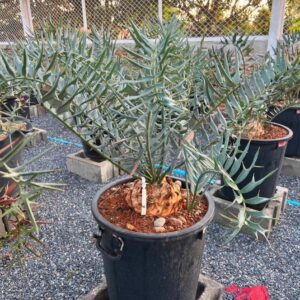Boophone disticha
Boophone disticha is a bulbous, tropical, and subtropical flowering plant endemic to Africa. It is commonly known as the century plant or tumbleweed. Here are some key facts about this plant:
-
: It has a distinctive fan-like arrangement of leaves and a large bulb that protrudes from the ground.
-
: The plant produces beautiful, sweetly scented inflorescences with rose-colored flowers, often appearing in autumn or winter.
-
: The bulb contains toxic alkaloids such as buphandrine, crinamidine, and buphanine, which can be fatal if ingested by livestock or humans in large quantities.
-
: Found in Angola, Botswana, Burundi, Democratic Republic of the Congo, Eswatini, Kenya, Lesotho, Malawi, Mozambique, Namibia, Rwanda, South Africa, Tanzania, Uganda, Zambia, and Zimbabwe.
-
: Thrives in dry savannas, grasslands, and forest clearings.
-
: Used for its analgesic and hallucinogenic properties. Parts of the plant are used to treat pain, wounds, and other ailments.
-
: Historically used by indigenous peoples as an arrow poison due to its toxic compounds.
-
: Requires well-drained soil, moderate watering, and full sun to bright light. It has a slow to moderate growth rate.
-
: Handling should be done with caution due to its toxic nature
What are the traditional uses of Boophone disticha in African medicine
is extensively used in traditional African medicine for a variety of purposes. Here are some of its traditional uses:
-
: The plant is used to treat painful wounds, burns, rashes, ulcers, and other skin disorders such as eczema. Parts of the plant are applied topically to wounds and boils to aid healing.
-
: It is used to treat ailments related to the central nervous system (CNS), including headaches and anxiety.
-
: The plant is used to treat inflammatory conditions, rheumatic pains, and arthritic swelling.
-
: Bulb decoctions are used to treat gastrointestinal problems like varicose ulcers and abdominal pain.
-
: It has been used for divinatory purposes and in cultural rituals.
-
: Historically, the plant was used by indigenous peoples to make arrow poison due to its toxic alkaloids.
-
: It is also used to treat urinary infections, tonsillitis, and as a detoxifying agent.
These uses highlight the plant’s significance in traditional African medicine, despite its toxic nature, which requires careful handling.
how to cultivate Boophone disticha
Cultivating Boophone disticha requires careful attention to its specific needs. Here’s a guide on how to cultivate this plant:
-
: Use a well-draining potting mix that includes a combination of compost and sand. A mix with 25% pumice or similar materials can also be beneficial for its deep root system.
-
: The soil should be slightly acidic.
-
: Boophone disticha thrives in full sun but can also tolerate semi-shaded conditions. Direct sunlight can be harsh during propagation, so bright indirect light is recommended for young plants.
-
: Optimal growth occurs between 65-75°F (18-24°C). It is theoretically hardy to -5°C but is not very frost tolerant.
-
: Maintain a humidity level around 70-80% during propagation to prevent fungal issues.
-
: Water sparingly, allowing the soil to dry out between waterings. Overwatering can lead to root rot.
-
: Keep the plant almost dry during its winter rest.
-
: Apply a slow-release fertilizer during the growing season to promote healthy growth.
-
: Use deep pots with a diameter of at least 25 cm to accommodate the plant’s deep root system.
-
: Plant the bulb so that the neck and part of the bulb are above the ground.
-
: Harvest seeds when the fruit is dry, clean them thoroughly, and sow them immediately. Germination takes about two months, and flowering may occur after several years.
-
: Separate offsets when they have developed their own roots. Allow them to form a callus before planting in well-draining soil.
-
: Protect the plant from frost by keeping it in a dry, unheated greenhouse during winter.
-
: Handle the bulb with care due to its toxic nature.
By following these guidelines, you can successfully cultivate Boophone disticha and enjoy its unique beauty and medicinal properties.




Reviews
There are no reviews yet.